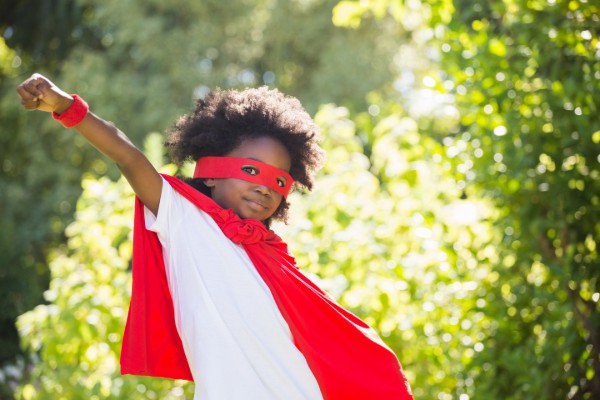This article will suggest how you can support, guide and promote your child’s learning and development if they are interested in superhero-themed play

What is Superhero Play?
Superhero play is a form of imaginative or dramatic play in which children use figurines, costumes, or other props as accessories to imitate the superheroes that they admire. A type of play that can involve some sort of dispute or disagreement, and the outcome is ‘typically’ resolved through a battle or fight. We find that if a setting or environment does not allow superhero play, this type of play will still happen, but will be explored by children when not in the sight of adults. Children usually try to hide this type of play in hidden areas and in enclosed spaces and stop when spotted by an adult or pretend that they are playing something else. Children often use guns in this type of play but will quickly hide them or change the name of the object if seen by an adult.
Why Support Superhero Play?
Children learn best when they are interested and engaged in a subject. Superhero play in the early years can be a fantastic interest to explore. Superhero play is not just aimed at boys, but many girls feel inspired and excited by a superhero play. The superheroes you may choose to promote to your child, or their play do not have to be the usual Spiderman or Batman but can be any fictional character with any superpowers that you choose – or even one that you make up as a family! This makes the possibilities exciting and endless. Children find superhero play very engaging and this can be used to not only promote positive behaviour but also to encourage learning in any area of the Early Years Foundation Stage. It captures children’s imagination and allows them to freely explore the world around them and to make sense of the world through discussing a character or pretending to be a character.
Let’s Explore the Benefits of Superhero Play in The Characteristics of Effective Learning – part of how children learn within the Early Years Foundation Stage Curriculum Guidance.
We often find that when children engage in Superhero play that the following is covered in this type of experience:
- Participation in an open-ended activity
- Use of symbolic representation (using a blanket as a cape)
- Taking on a role in their play
- Paying attention to details
- Demonstrates satisfaction of meeting own goals
- Persisting when a challenge occurs
- Being proud of accomplishing something without an end result
- Initiating play ideas
- Seeking challenge
- Taking risks, engaging in new experiences and learning by trial and error
- Maintain focus for a period of time
- Demonstrate high levels of energy and fascination
- Bouncing back after difficulties
- Enjoying meeting challenges for their own sake rather than external rewards or praise

How does Superhero Play Support Positive Behaviour?
Superheroes have many qualities which the children will want to share and often they will look to superheroes as icons and role models. Therefore, using superheroes and concentrating on their qualities rather than the fact they fight the bad guys, can lead to some fantastic learning for children. Some of the qualities you may choose to incorporate into your superhero theme are:
- Superheroes are always kind to others
- Superheroes are always helpful to others
- Superheroes always try their best
- Superheroes are hard workers
- Superheroes always try to save the day
The options are endless for superhero play and once the children have grasped the concept that superheroes are more than fighting bad guys you could incorporate real-life superheroes into your play. For example, firefighters, hospital workers, vets, police officers these are all seen as real superheroes as they have all the qualities listed above and try to save people or animals. This is a brilliant way to get involved in the local community and arrange some outings or experiences for your child. You may also choose to involve superheroes from the animal world who have superpowers. For example, ants are incredibly strong and can carry things that are much heavier themselves or cheetahs who can run incredibly fast. The possibilities are endless with superhero topics and play and the children have so much fun that learning does not feel like a chore. Be inventive and creative with how you incorporate superhero play into your home and let the magic begin!!!

Our Favourite Superhero Activities at Nursery
- Baking superhero cupcakes
- Use sensory trays for Cobwebs, using cotton wool, spiders for Spiderman – going on a spider hunt in the garden
- Making superheroes using playdough
- Being inspired by the colours associated with the hero e.g. Green water for the Hulk
- Create your own superhero-based sensory experience as well such as ice, salt, pipettes for “Ice Women”
- Read stories such as Superworm and Wonderpants Underpants
- Making up stories and books for our own characters and acting out the scenes within
- Superhero yoga poses
- Create a superhero “station” with keyboards, headphones, telephones, maps, clipboards, paper, and pencils, thinking of your own superhero or superpowers
- Be creative and design your own superhero logo using the first letters of your child’s name
- Make “scan to enter” signs using handprints, thumbprints and footprints.
- You could always have a superhero dress-up day / party and play
- Superhero target throw – easy to do using scrunched up newspaper and buckets/ bins – have a score sheet and record the distances thrown or assign a number or activity to a bucket
- Superhero obstacle course/ the floor is lava etc – which includes; superhero poses, star jumps, rolling over, crawling through tunnels (chairs and blankets are great tunnels)
Tips on How to Kerb Unwanted or Hurtful Behaviour
Support children during this type of play using the opportunity to distract away from or discuss together anything hurtful or negative. Distraction works better for younger children, for example, move from hitting to climbing up and jumping off something suitable. Discussion and refocus for older children work generally. Discuss why the behaviour or actions is unwanted and hurtful. Discuss the consequences of this and think about solutions and then move on to play in a different way.
or actions is unwanted and hurtful. Discuss the consequences of this and think about solutions and then move on to play in a different way.

